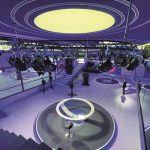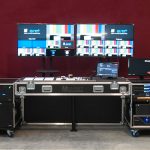Designed for use in applications such as aerial video capture and studio robotics, the camera promises to capture broadcast-quality colour video across an extremely wide range of night or daytime conditions.
Ikegami has announced a new addition to its range of broadcast-quality cameras. The UHL-F4000 is a compact and lightweight 4K HDR camera with very low power consumption. Designed for use in applications such as aerial video capture and studio robotics, the camera promises to capture broadcast-quality colour video across an extremely wide range of night or daytime conditions. Image adjustment capabilities include haze removal, backlight correction and digital zoom.
Developed from Ikegami’s high-definition HDL-F3000, the UHL-F4000 is being introduced for the programme producers seeking to future-proof their work by mastering in 4K. The camera claims to deliver HD cutout images as well as 2160p 59.94 or 50 Hz 4K. The image sensor unit uses three CMOS global shutter elements so there is no rolling shutter distortion even in aerial imaging applications where subjects are constantly moving in parallel.
Further features include variable contrast control which can handle situations of reduced visibility such as fog or smoke. An image sharpening function is incorporated and a vertical image reversal mode allows the camera to be mounted upside down. The operator can adjust the camera in real time for optimum noise reduction when shooting at night with high gain.
The UHL-F4000 camera head measures 100 x 128 x 90 mm WHD and weighs only 1.1 kg. Digital zoom from 1.01x to 10.0x magnification, including gradual acceleration, can be combined with a BTA S-1005B-mount optical zoom lens to achieve natural long-range wide-angle to close-up effects. Minimum illumination level in standard operating mode is 0.0015 lux at F12. A focus-assist function places the edge components of the 4K image on the high-definition monitor output feed.
Aberration correction can be performed using data from the lens servo block. Aberration correction is also possible if the servo block is removed from the lens to be used in the limited space of a gimbal. An integral motorised neutral density filter can be set to 1/4, 1/16, 1/64 or 1/256. Colour correction can also be adjusted. The camera head consumes very low power as all video processing is performed in a separate base station.
A 40 Gbps duplex optical fibre connection communicates between the camera head and base station. These can be positioned up to 10 km apart. The optical fibre can be integrated into one bidirectional core via an optical circulator and passed through a single-core optical rotary joint used for a small gimbal.
The base station is also compact, measuring 145 x 145 x 173 mm WHD and weighing 2.5 kg. It simultaneously outputs 4K and HD video compatible with HDR. It uses the same AXII high-speed video processor as that incorporated in Ikegami UHK-430 and UHK-435 studio/broadcast cameras, supporting a variety of imaging styles.
The Ikegami UHL-F4000 camera head can be mounted on a motor-driven pan/tilt head for robotic operation in a studio. In this configuration, the genlock or remote control cable can be connected to the base station so that the cable does not obstruct camera movement.
“Aerial photographers working from helicopters are increasingly keen to use 4K cameras,” comments Michael Lätzsch, Broadcast and Professional Video Division Manager at Ikegami Electronics (Europe) GmbH. “4K cameras tend to be larger and heavier than HD models so require a larger anti-vibration gimbal. In addition, the higher power consumption of 4K cameras causes the internal temperature to rise if a 4K camera is placed in a sealed stabilising unit. This shortens the camera’s lifetime and can even lead to sudden failure. The UHL-F4000 overcomes all these challenges. It is a robust and compact camera head with low power consumption delivering very high image quality.”

















































































